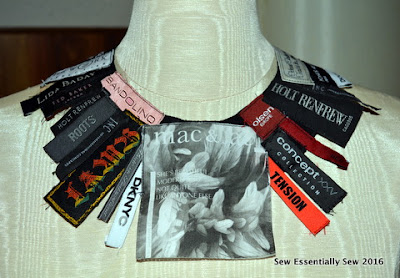Woo-wee! Twenty-four darts, three layers later, a whole lot of hand-stitching, and I finally have myself a winter coat. This will have to go down as the most rewarding sewing project that I've made ever. To be completely honest, after all the fear and mind-changing involved in the process, I can't believe that it's done. After five years of
planning procraftinating on making a coat, I finally did it! And I will have to admit, in the end it was an easy pattern to work with.
The Fabrics:
The fashion fabric is 100% wool that I found at Fabricland about five or six years ago when it went on sale at 70% off. I was more drawn to the price than I was to the colour and pattern. I will admit that it has grown on me since I picked out this fabric.
I pre-treated this wool with steam before I cut it out. The plan is to dry-clean this coat if and when it needs it. This is going into the wardrobe as my good coat to wear during my off-work time. I don't want to risk getting it dirty or damaged during recess duties. Although it is warm enough to handle standing / walking around in the prairie cold.

The inside is a cotton backed Kasha lining, in pink-ish sort of colour. ~gasp!~ Honestly, I don't know how so much pink and pink-like shades are finding their way into my fabric stash and wardrobe. Again, the only reasonable explanation would be a ridiculously awesome price on this lining fabric. Which could be very likely by that masking tape means I picked it up at Northwest / Marshall Fabrics many moons ago since this lining rarely goes on sale at Fabricland. What can I say, bargain wins over colour. And to be completely honest, I actually like it now that it is all put together. The lining fabric was pre-treated with a tumble through the washing machine and dryer and it handled the process well.
The coat has a light-weight fleece underlining. Also, another fabric in a colour I wouldn't normally pick, but I was thinking about warmth and price. I found this at Fabricland several years ago. It was also pre-treated with a tumble through the washing machine and dryer cycles. I'm hoping that this underlining would give the coat the extra warmth factor needed to survive through a prairie winter.
And the front bands, collar and hem bands were all interfaced with fusible interfacing. For picking out fabrics that are not normally in my colour palette, I'm pretty thrilled with the final project.
:
Would you believe that
Vogue 8934 was not my first choice when I started to think about making a winter coat? My initial plans revolved around a vintage Vogue design, out-of-print (OOP) Vogue 1083.
Of course, this was before Marcy Tilton released
this pattern in 2013. There is a reason why Marcy Tilton is one of my favourite designers and this coat pattern is a perfect example. I have no complaints about this pattern and only have wonderful things to say about this design. Let me start by saying this is a perfectly drafted pattern.
 |
| Vogue 8934, another fabulous Marcy Tilton design. |
My favourite part of this design is the treatment of the hem with those darts and the way it is finished. I like that this is a loose-fitting design and it will be roomy enough to wear with a bulky sweater underneath if I wish or need. Oh and that front fly closing came together with help from some well-written instructions.
The only adjustment to the pattern was to shorten the sleeve length. Even though I'm five foot and almost and inch tall, I did not shorten the length of the coat and I'm happy with the length and the way it looks.
:
Oh my goodness, I really like these buttons. I drove all the way to Mitchell Fabrics in search of buttons. Although, I have been recently finding some cool fabrics and notions at Fabricland, I'm not all that smitten over their button selection. Sorry. Thankfully, I can find some cool vintage and retro style buttons at Mitchell which makes it worth the trip. The pattern only asks for six buttons but I made my coat with eight. It can get windy here and the more coverage, the better.
The Upgrades:
I will admit that I winterized this coat. Along with underlining the coat, there is a hidden elasticized cuff inside the sleeve. I took my inspiration from a vintage jacket that I picked up a couple of years ago when
I fell off the ready-to-wear fast wagon. It seems like vintage coats of a certain era and quality have these wonderful elasticized cuffs. Why in the world did they stop making coats with this feature? I love how it turned out.
There is still enough fabrics left over to make a lined hood and I have four smaller sized buttons to attach to the collar. It may be a possibility in the near future. Right now I'm happy it is done even without the hood.
The Stats:
Fabric: 6.7 metres total (2.3 metres of fashion fabric, fleece underlining fabric and lining fabric)
Interfacing: 1.7 metres fusible interfacing
Buttons: 8 buttons
Elastic: .5 metres 1/2" wide elastic
Threads: I managed to finish off 4 spools (previously used) of thread for sewing and hand stitching and one spool of serger thread.
Additional Tools and Supplies: Sewing machine, serger, thread, clippers, scissors, seam ripper, cutting table, needles, thimble, pins, tailor's ham, sleeve ham, clapper, iron, ironing board, pressing cloth, tweezers, wrist brace, Kleenex tissues, cough syrup, Advil, lots of bed rest (honest, it wasn't more procraftinating) ginger ale, and some good tunes when the headaches subsided.
Happy Sewing!

























































.jpg)


